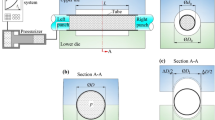Abstract
With the development of manufacturing industry, metal tubes and rods are used more and more widely in automobile, aviation, and aerospace fields. Rotary swaging, a competitive plastic-forming technology for manufacturing tubes and rods, can realize net-shape forming for high-quality workpiece. However, in order to control the forming precision of tube or bar workpiece, the complex mechanical system was needed in the conventional swaging machine. In this paper, a rotary swaging process utilizing energy-controlled method is proposed, which can improve the flexibility of the process and control forming diameter of the tubes by changing the forming energy. In the swaging machine, a servo motor and its control system were used to change the speed of the rotary swaging spindle. And then, the swaging energy of the hammer die can be controlled. Rotary swaging experiments of pure copper tubes were conducted on the developed rotary swaging machine. These tubes with outer diameter of 8.0 mm and wall thickness of 1.0 mm were formed to necking tubes with different outer diameters. Meanwhile, the relationship between the speed of the spindle and the forming diameter of the formed tube was obtained. The metallographs of the formed tubes showed the compact structure and continuous streamline. To investigate the metal behavior under different energy of the hammer die, Transvalor Forge 2011 was used to simulate the rotary swaging process of tubes based on energy-controlled swaging method. The metal flows in radial, axial, and circumference directions, emerging axial elongation and necking deformation. Comparing the experimental results with the simulated ones, the deformation condition and thickness distribution are in good agreement.
Similar content being viewed by others
References
Altan T, Oh SI, Geogel H (1983) Metal forming fundamentals and applications. Materials Park, OH: American Society for Metals 17
Ghaei A, Movahhedy MR, Karimi Taheri A (2005) Study of the effects of die geometry on deformation in the radial forging process. J Mater Process Technol 170:156–163
Ghaei A, Karimi Taheri A, Movahhedy MR (2006) A new upper bound solution for analysis of the radial forging process. Int J Mech Sci 48:1264–1272
Sanjari M, Karimi Taheri A, Ghaei A (2007) Prediction of neutral plane and effects of the process parameters in radial forging using an upper bound solution. J Mater Process Technol 186:147–153
Li R, Nie ZR, Zuo TY (2007) 3D finite element modeling of cogging-down rotary swaging of magnesium square billet-revealing the effect of high-frequency pulse stroking. Mater Sci Eng A 464:28–37
Ghaei A, Karimi MMR, Taheri A (2008) Finite element modeling simulation of radial forging of tubes without mandrel. Mater Des 29:867–872
Sanjari M, Saidi P, Taheri AK, Zadeh MH (2012) Determination of strain field and heterogeneity in radial forging of tube using finite element method and microhardness test. Mater Des 38:147–153
Li Y, He T, Zeng ZX (2013) Numerical simulation and experimental study on the tube sinking of a thin-walled copper tube with axially inner micro grooves by radial forging. J Mater Process Technol 213:987–996
Abdulstaar MA, El-Danaf EA, Waluyo NS, Wagner L (2013) Severe plastic deformation of commercial purity aluminum by rotary swaging: microstructure evolution and mechanical properties. Mater Sci Eng A 565:351–358
Kuhfuss B, Moumi E, Piewk V (2008) Micro rotary swaging: process limitations and attempts to their extension. Microsyst Technol 14:1995–2000
Piwek V, Kuhfuss B, Moumi E, Hork M (2010) Light weight design of rotary swaged components and optimization of the swaging process. Int J Mater Form 3:845–848
Zhang Q, Jin KQ, Mu D (2014) Tube/tube joining technology by using rotary swaging forming method. J Mater Process Technol 214:2085–2094
Author information
Authors and Affiliations
Corresponding author
Rights and permissions
About this article
Cite this article
Zhang, Q., Jin, K., Mu, D. et al. Energy-controlled rotary swaging process for tube workpiece. Int J Adv Manuf Technol 80, 2015–2026 (2015). https://doi.org/10.1007/s00170-015-7054-x
Received:
Accepted:
Published:
Issue Date:
DOI: https://doi.org/10.1007/s00170-015-7054-x




